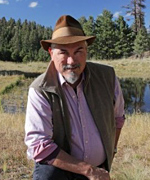 —Alan Dulaney
—Alan Dulaney
It is a warmer and drier era; the sun shines relentlessly and the wind blows freely. In the new era, these sources generate electrical energy, but only during the daylight hours. In the old water-energy nexus paradigm, water was transformed into steam by burning coal or gas so as to turn generators, or to provide cooling for other steam sources such as nuclear reactors, or to use the hydraulic head behind a dam to spin the generators. But paradigms evolve, and ideas to use water as a battery for energy storage (pumped storage) are more frequently put forth.
Much of California has invested heavily in solar and wind power, only to find that the massive diurnal generation of electricity does not entirely match the demand. They have more energy than they can directly use. Batteries sufficient to store that much excess electricity don’t exist. The surfeit of power has produced some interesting side effects in Arizona. For example, California is providing energy at almost negative rates during the day to anyone willing to take it, even Arizona, leading to a recent re-structuring of the CAP energy portfolio to take advantage of nearly free energy.
A couple of years back at the Arizona Power Authority, I heard an interesting presentation by engineers from the Los Angeles Department of Water and Power (LADWP). The LADWP engineers’ concept involved using excess electricity to pump water behind a dam during the day, then releasing it at night to generate hydroelectric power, thus recovering the stored energy. They have done a pilot project in California, and the concept appears to work. They wanted to go full-scale with the concept and make wind and solar power more economically successful. The idea sounded pretty intriguing until they mentioned that LADWP had in mind using Hoover Dam and Colorado River water.
Aside from the huge capital investment in pumps and pipes ($3 billion), any tinkering with water level elevations in Lake Mead would worry every user of Colorado River water in the Lower Basin. At the time, a declared shortage loomed over all three states — but especially Arizona — and I could easily foresee major objections and litigation over this new use of over-allocated Colorado River water. After the presentation, I mentioned the possibility of decreased flows, falling water-level elevations, and a declared shortage; the LADWP folks seemed surprised to hear that other Lower Basin users might have concerns. I haven’t heard the proposal put forth since, at least in Arizona. But it is still on the table in Los Angeles.
A similar concept has been proposed for Yavapai County, using sites that are not so fraught with adverse implications. The basic concept is to construct two reservoirs at different elevations, pump water into the higher reservoir with excess electricity, then recover the energy via hydroelectrical generation in a closed loop system. You can read about the concept here. The Prescott City Council has joined in with ITC Holdings in a preliminary filing with the Federal Energy Regulatory Commission (FERC). Groundwater studies are underway, and stakeholder meetings are scheduled. So far, the biggest problem seems to be the 27,000 acre-feet of groundwater from the Big Chino basin that would be required for the initial fill, plus the 945 acre-feet needed annually to balance evaporation. No surface water rights would be needed.
The latest pumped storage proposals are more controversial, largely because of proposed locations within a few miles of the Grand Canyon. Read about it here. Pumped Hydro Storage LLC has filed applications with FERC to begin preliminary studies for two projects on the Little Colorado River near its confluence with the mainstem Colorado River. Both appear to include dams within the gorge of the Little Colorado, with upper reservoirs on the plateau above. These applications immediately aroused environmental groups, who noted destruction of habitat for the hump-backed chub, loss of needed sediment flowing into the Colorado, elimination of the blue color of water that stems from Blue Springs upgradient from the dams, and cultural resources issues associated with flooding Hopi sacred sites. Pumped Hydro Storage LLC has apparently talked only with the Navajo Nation, not the Hopi Tribe, nor has it mentioned where it will obtain surface water rights to the Little Colorado River. And these concerns don’t include the loss of several thousand acre-feet of unregulated flow into the Colorado River system annually, and the resulting ire of Lower Basin states. I don’t see how this proposal will ever gain support.
The ITC proposal shows that pumped storage can be done without impacting the Colorado River. With the mismatch between diurnal generation from solar and wind and the nature of electrical demand, the day (and night) of pumped storage has arrived. Using water as a battery is a good concept. This much is certain: hydrologists and water resources professionals will be needed to make it happen.